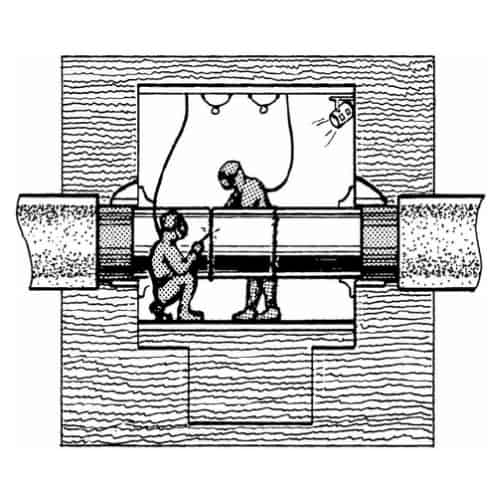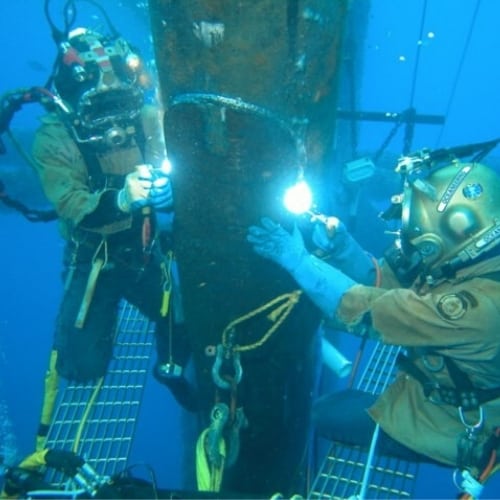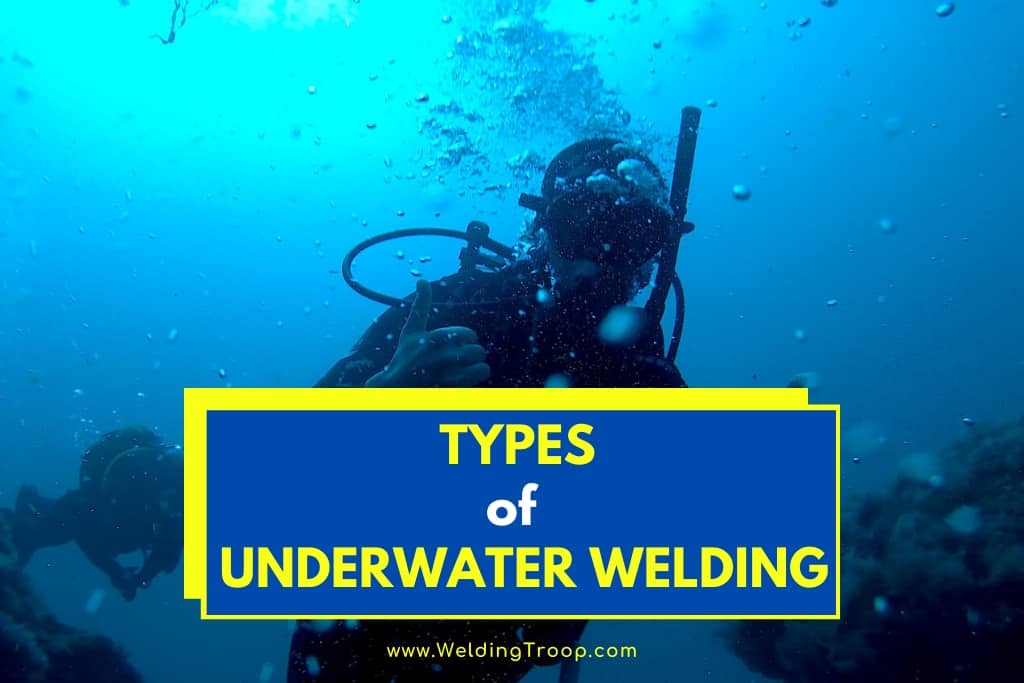Have you ever asked yourself what different type of welding is used in underwater welding? When the average person first hears about underwater welding, their initial reaction is often one of astonishment and concern.
Welding makes use of electricity and great amounts of heat – how can that possibly be compatible with underwater work? Those who work in the welding industry know that not only is underwater welding possible, but that it can be incredibly lucrative. The average underwater welding salary is around $54,000, with the top earners pulling in six-figure salaries.
What Type of Welding Is Used in Underwater Welding? Well, underwater welding is split into two different types or categories, Dry Welding and Wet welding, each of which features different subcategories. Each type of underwater welding has its upsides and can be used for any number of jobs.
With that in mind, let’s dive right in and see how underwater welding works and how, with the right preparation, it can work for you career-wise.
Table of Contents
Dry Welding Overview
Of the two major varieties of underwater welding, dry welding is the most common. Otherwise known as hyperbaric welding, this type of underwater welding is conducted within a hyperbaric chamber, which helps mitigate the risk.
That said, it is essential that the gas levels and other conditions within the chamber are monitored very carefully. In addition, these chambers are pressurized so as to avoid underwater welders getting the bends.
Of the two main varieties of underwater welding, dry welding by far has more variants.

#1: Habitat Welding
One of the most commonly practiced of these is habitat welding, which most closely follows the aforementioned concept of welding from within a small hyperbaric chamber. This method is especially useful when carrying out welding where the heat generated from the welding arc may be too extreme for a welder to be safely exposed to in the open air (or water).
In this method, the welder sticks their welding arc through a slot and does the work on the other side of the chamber. Gas is continuously pumped into the chamber to ensure that it remains breathable. The pressure inside the chamber is higher than outside, resulting in osmosis as the gases escape from the former into the latter. This, combined with the welder being separated from the heat of the welding arc, mitigates the risk of the heat from the welding arc igniting the vapor or the pressurized air within the chamber.
Learn More About Hyperbaric Welding – Here, you can find an article from our website: What Is Hyperbaric Welding? All You Need to Know
Hyperbaric chambers themselves range in size from being just big enough for one welder to being large enough to accommodate a crew of two or three people.
Habitat welding is commonly practiced in jobs such as welding offshore oil rigs.
#2: Pressure Welding:
Pressure welding, also known as solid-state welding, makes use of controlled explosions and friction to generate the temperatures and conditions necessary to join pieces together.
It is also known as solid-state welding. Pressure welding is a broad term that includes different welding techniques that have one factor in common. They use mechanical pressure at the weld section to join them. There are several different forms of pressure welding, including:
- Ultrasonic welding
- Resistance welding
- Gas pressure welding
- Friction welding
- Diffusion welding
#3: Dry Spot and Dry Chamber Welding
Both of these techniques are most commonly employed with small hyperbaric chambers. In dry spot welding, the chamber is placed directly atop the welding area in such a way as to create a seal and dry spot for the welder to work. The seal must be tight and closely monitored at all times to guard against a breach and safety hazards.
Dry chamber welding works similarly, instead covering only the top part of the welder’s body so they and the object they are welding remain dry during the welding process. Welders typically enter the chamber from the bottom, with the chamber itself typically covering their heads and shoulders.
Related Article: Do Underwater Welders make Good Money?
#4: Gas Tungsten Arc Welding
Commonly known as TIG welding, this method makes use of electrodes featuring non-consumable tungsten. The electrode creates an electric arc that generates high temperatures, which in turn melts material along the joints being welded.
This method works well with and is primarily used for use with metal alloys. TIG welding takes more training than some of the other methods on this list, but the result is often some of the most durable welds.
#5: Gas Metal Arc Welding
Commonly known as MIG welding, this technique automatically involves feeding filler wire by way of a specialized welding gun. This streamlines the process, making it arguably the most accessible type of underwater welding among the dry options. MIG welding guns also feature shielding gas, which serves to protect the weld while it is hot.
#6: Plasma Arc Welding
This method involves using an electric arc positioned between the piece on which you are working and an electrode, which is usually sintered tungsten or something similar. This method is similar to TIG welding except that the electrode is situated within the body of the torch. As a result, the plasma arc is kept separate from the inert gas. Instead, the plasma is injected into the site at high speed by way of a copper nozzle.
Plasma arc welding is one of the most accurate types of welding on this list and can result in extremely high temperatures of 50,000 degrees Fahrenheit or more. For deep sea plasma welding jobs, divers usually work in pairs, working in shifts.
Related Article: 7 Steps for Avoiding Electric Shock When Welding Underwater
Read also >> Underwater Welding: The Only Guide You’ll Ever Need
Read also >> Offshore Underwater Welding Jobs: Description and Salary Details
Wet Welding Overview
In contrast to dry welding, which takes place in a controlled environment, wet welding is closer to what most laymen imagine when they think of underwater welding. Wet welding means welding while directly exposed to the water around you.

To do this without electrocuting or otherwise harming yourself, you’ll need to make sure you have the right equipment. Wet welding electrodes in particular are essential, as they allow you to use the materials necessary for welding in underwater conditions safely.
As with dry welding, there are several types of wet welding, many of which make use of special forms of arc welding. An arc is created between the metals and electrodes. These arch welding techniques are designed to maximize welding efficiency while minimizing risk.
Wet Welding Techniques
Shielded Metal Arc Welding is by far the most popular, used the vast majority of the time on a wide variety of tasks big and small. It is also known as “stick welding” due to the fact that welders employ a long stick-like electrode paired with the electrical arc in welding metals such as stainless steel and aluminum.
By contrast, Flux-Cored Arc Welding makes use of a continuous spool feed to give the welder a constant stream of filler material. This can be used for welding metal alloys and cast iron.
Then there is Friction Welding. This is a far more straightforward method of welding in which the metal is directly fused together by a great deal of heat and friction. There is no material melting in this form of welding, and it is most commonly used when dealing with thermoplastics.
There are several advantages to employing wet welding, including:
- Less expensive startup cost
- Fast application
- High-strength tensile materials
- Easier to access the spot you’re welding compared to dry welding
- No need for a hyperbaric chamber of other habitat
Comparing Dry Versus Wet
Now that we have laid out the differences between wet and dry welding and their different variations, let’s discuss the differences between each type of underwater welding.
One of the biggest considerations in any welding enterprise is cost. In this respect, dry welding is far more expensive at the start due to the expense of the hyperbaric chamber, which can cost a few thousand dollars per session.
It is also often far faster to carry out than dry welding. This is due in part to the fact that, without the hyperbaric chamber, there are far fewer variables to keep track of, allowing welders to focus on and finish the actual welding that much more quickly.
That said, while wet welding can be more affordable at first, the cost of acquiring and maintaining specialized welding electrodes can add up over time.
Many of the techniques used in dry welding are more accurate and can handle tougher materials. In addition, the sheer variety of options offered by dry welding allows for more approaches to jobs.
Finally, the hyperbaric chamber itself and the protection it affords makes dry welding a safer option than wet welding, though with proper diving and welding training either can be pursued safely.
Just as for every task there is a proper tool, for every deep sea or shoreline welding job there is a type of underwater welding that can best be used to achieve the goal. Whatever the task, you will want to make sure you are using the proper diving and welding equipment, and that you check the veracity and quality of each before using them.
When practiced correctly, both dry and wet welding can account for some of the most impressive and lucrative welding jobs.
Underwater Welding Salary
Underwater welding is a profession that can earn divers a good salary without requiring extensive education. Some experienced and certified divers earn over $300,000 per year, and location plays a significant role in pay.
Underwater welding is divided into two types, offshore and inland, with offshore divers working on oil pipelines, drilling support, and ship repairs, while inland divers work on water towers, bridges, and dams. The pay for underwater welding jobs varies worldwide, but the US has one of the most extensive underwater welding sectors.
The average hourly pay for an underwater welding job in the US ranges from $13.94 to $28.37, with an average hourly pay of $21.56
Types of Underwater Welding Equipment
There are three essential pieces of equipment required for underwater welding, which include a welding machine, stinger, and electrodes. The welding machine must be suitable for use in a highly conductive atmosphere. Stingers, also known as electrode holders, provide an outlet for power and give the welder control over their arc.
Wet welding electrodes come in different diameters and quality levels and must be suited to the electrode holder. Prices for these pieces of equipment range from $100 – $350. Underwater welders use this equipment to repair pipelines, offshore oil drilling rigs, ships, dams, locks, and sub-sea habitats.
Underwater welding is categorized into two types, wet and dry welding. Wet welding is done directly in the water using shielded metal arc welding (SMAW), while dry welding is done in a specially constructed enclosure or chamber using processes such as gas tungsten arc welding (GTAW).
How Many Amps Is An Underwater Welder?
Underwater welders use direct current welding generators that are capable of producing a minimum of 400 amps to produce satisfactory welds. However, the specific amperage used for welding may vary based on the depth of the water, the thickness of the plate, and other factors.
For instance, if a welding machine operates at 275 amps for a 60% duty cycle, it means that you can weld full-throttle for 6 minutes out of 10.
Is TIG used Underwater?
Yes, TIG welding can be performed underwater. However, it’s important to note that underwater welding is a specialized and hazardous field that requires a lot of training and practice.
Additionally, underwater welding involves both wet and dry welding techniques. Wet welding is the most common method used in underwater welding and primarily relies on shielded metal arc welding (SMAW).
Can You Use a MIG Welder Underwater?
MIG welding is not typically used underwater. Underwater welding primarily relies on Shielded Metal Arc Welding (SMAW), also known as stick welding, due to its cost-effectiveness and versatility in wet environments.
However, it is possible to perform TIG welding underwater, but this process is highly specialized and hazardous and requires extensive training and equipment.
It is important to note that underwater welding, regardless of the method used, poses significant risks and requires strict safety protocols to prevent gas explosions or suffocation.
Do Underwater Welders Get Attacked?
There is always a risk of being attacked by dangerous marine life while underwater, but it is not a common occurrence for underwater welders. However, underwater welding is a hazardous field that requires strict safety protocols to prevent accidents. Underwater welders face risks such as drowning, hypothermia, decompression sickness, electrocution, and exposure to explosive gases.
It is important to note that specialized training and equipment are required to perform welding underwater, and SMAW is the most commonly used welding process for underwater welding, while MIG welding is not typically used in this field.
Recommended Reading
Advantages of Being a Welder >>Salary, Working Hours | Worklife Balance

